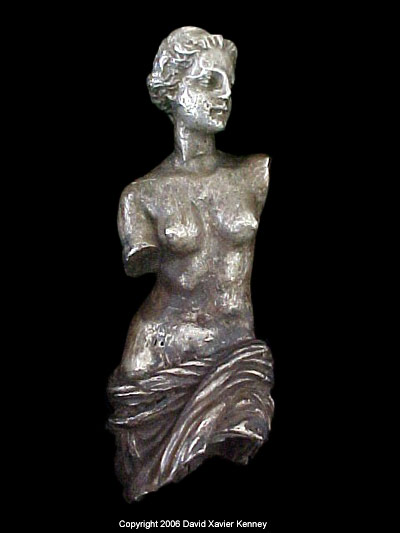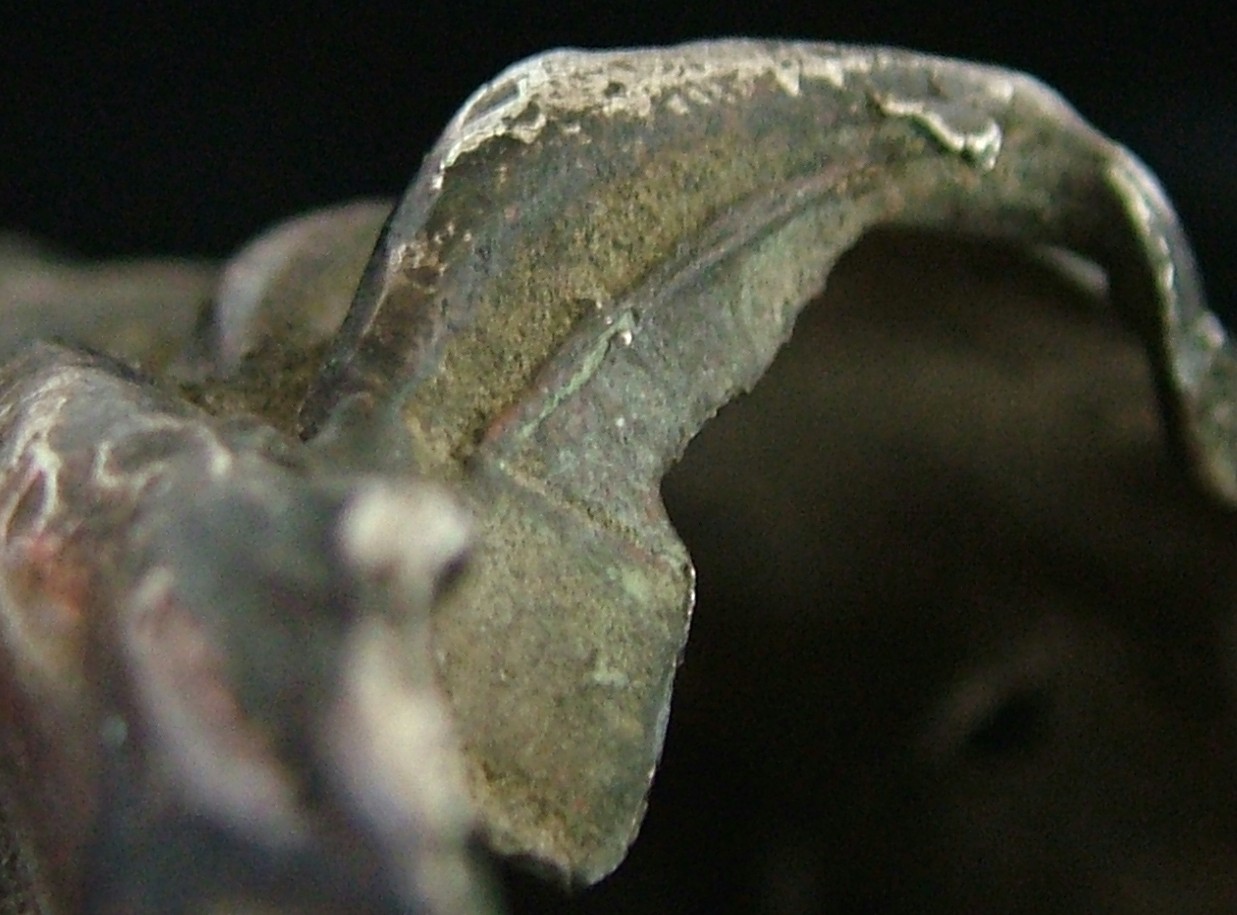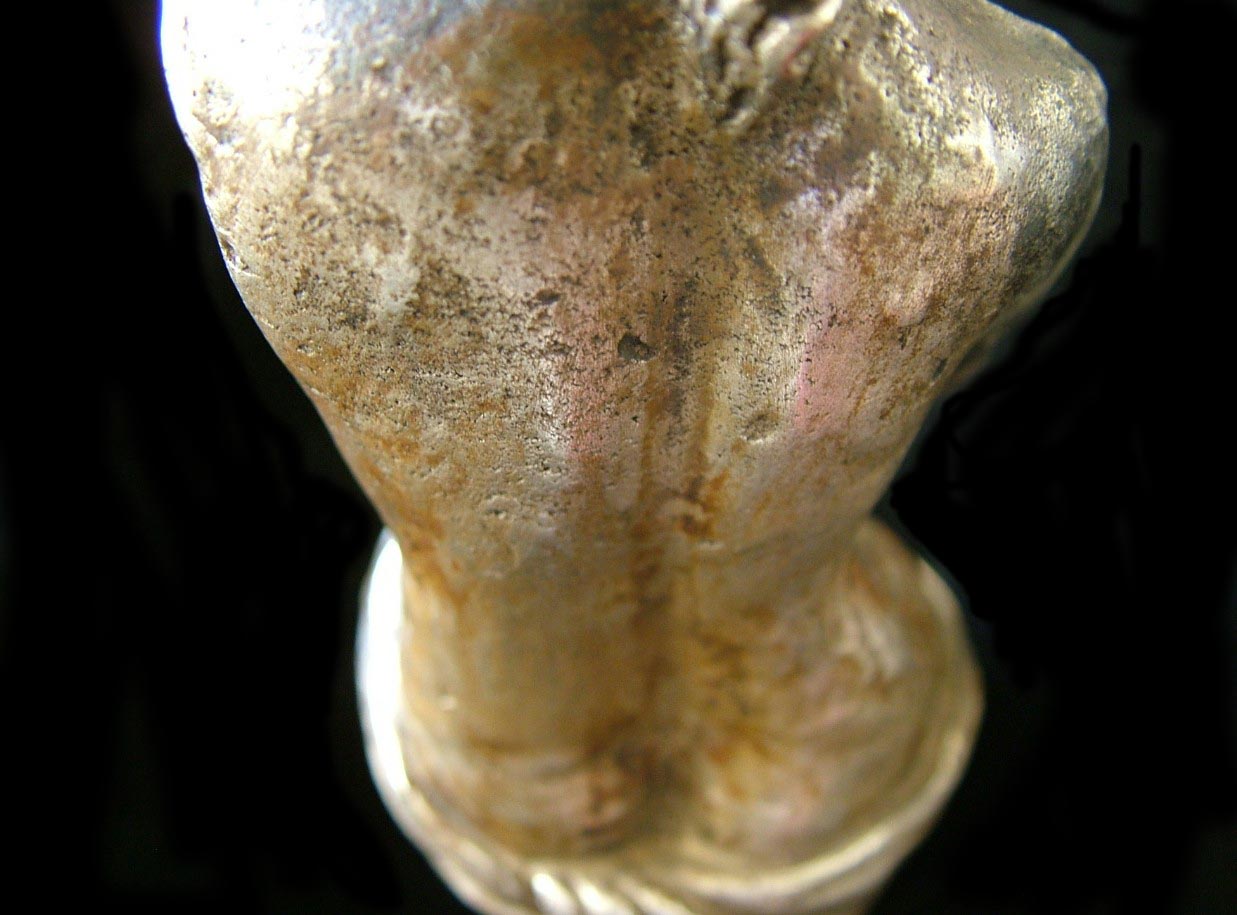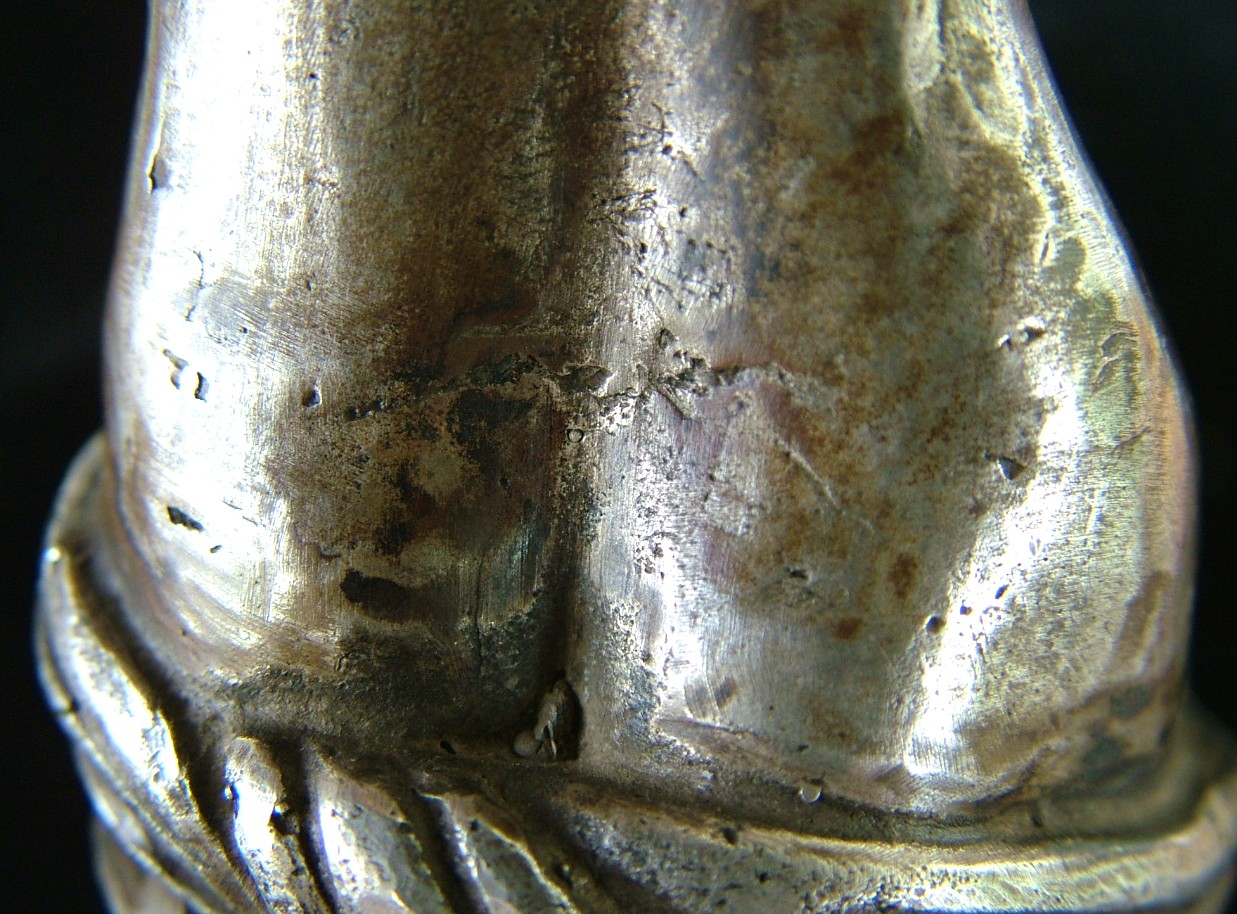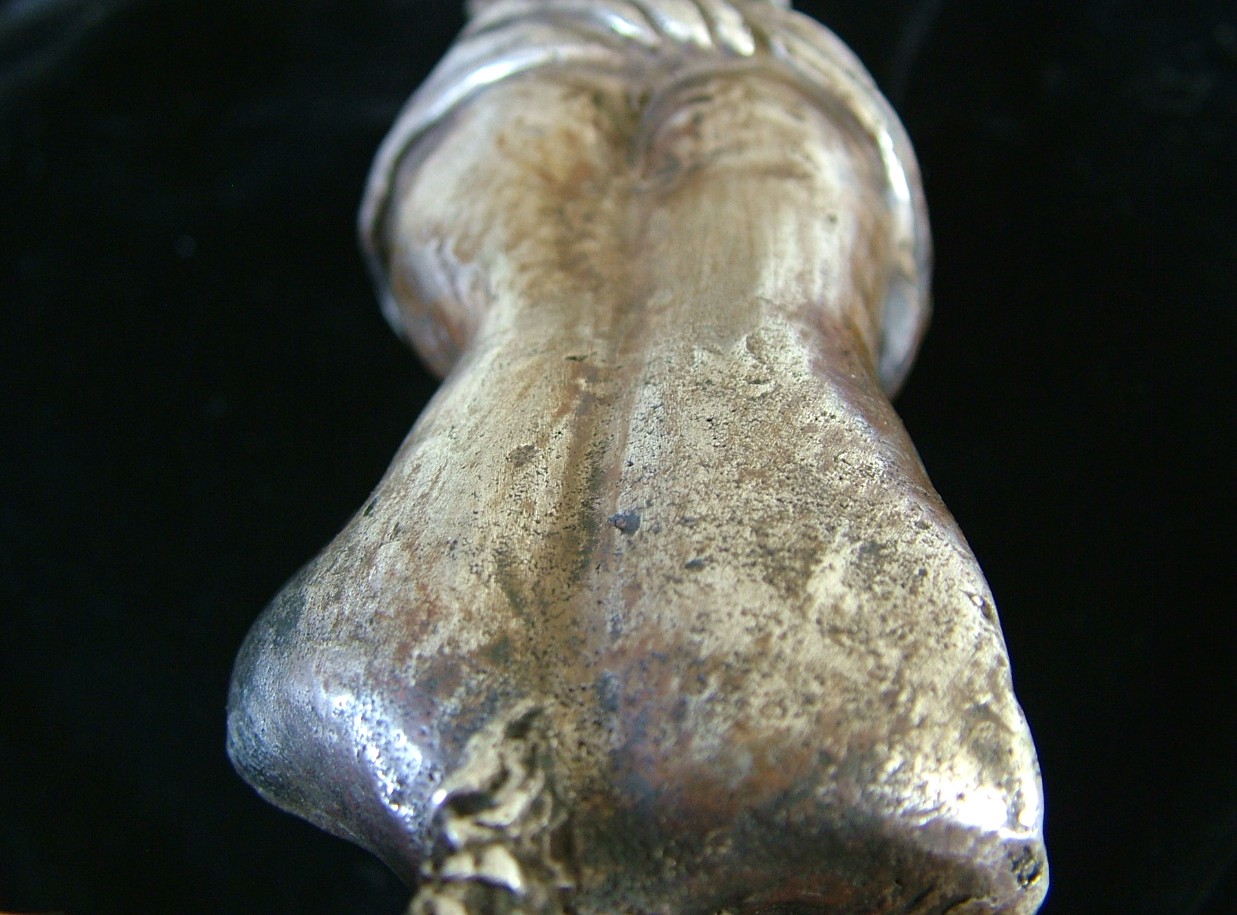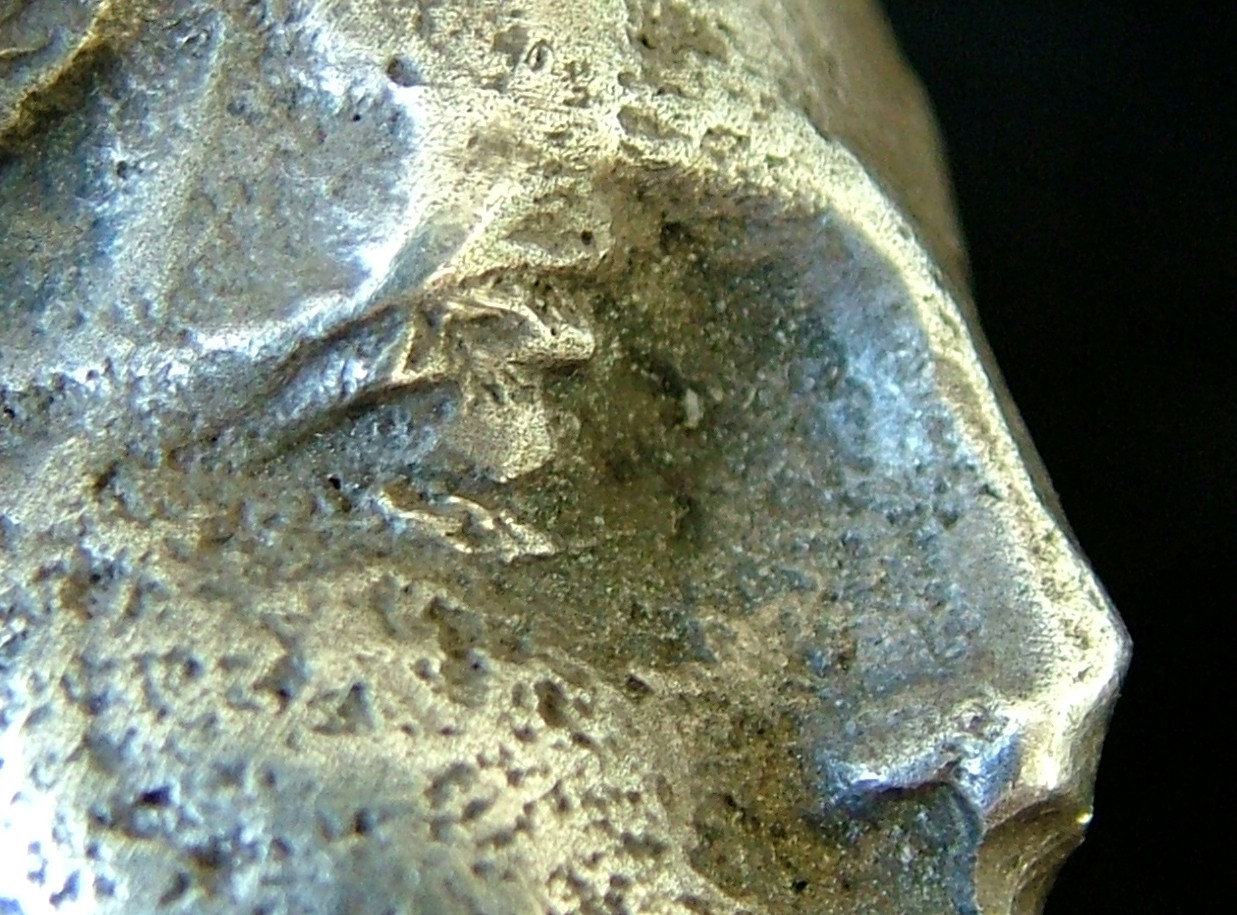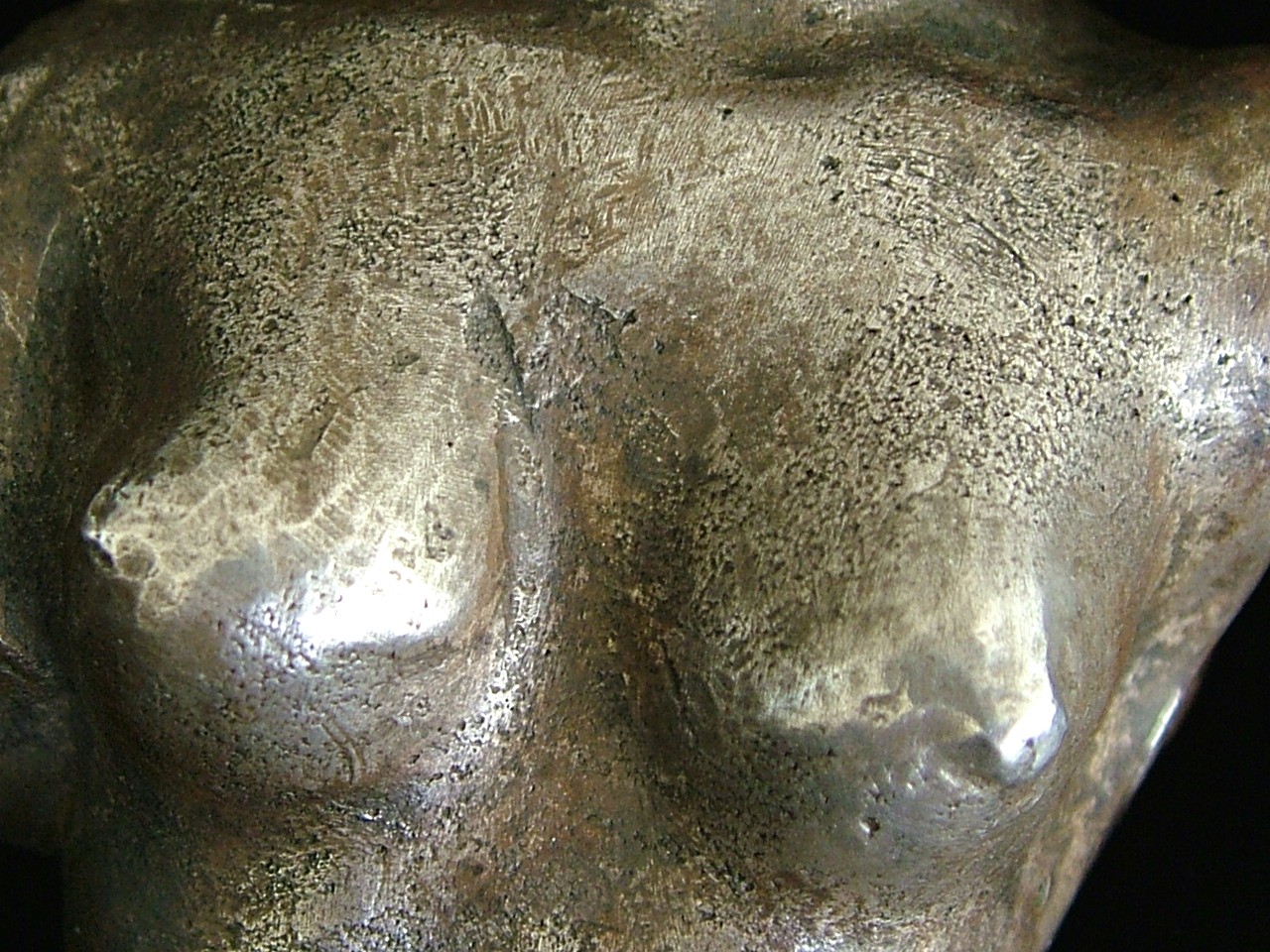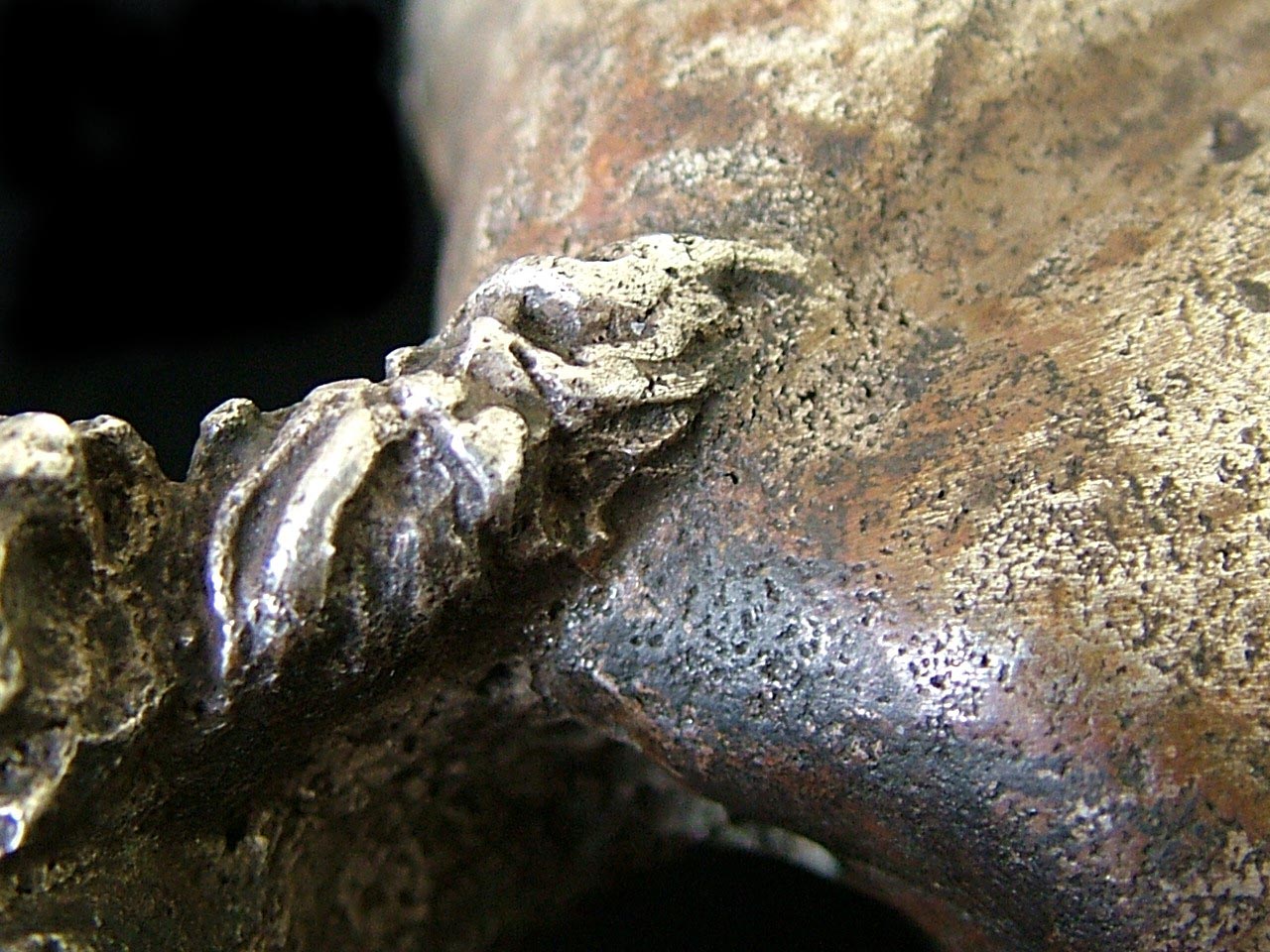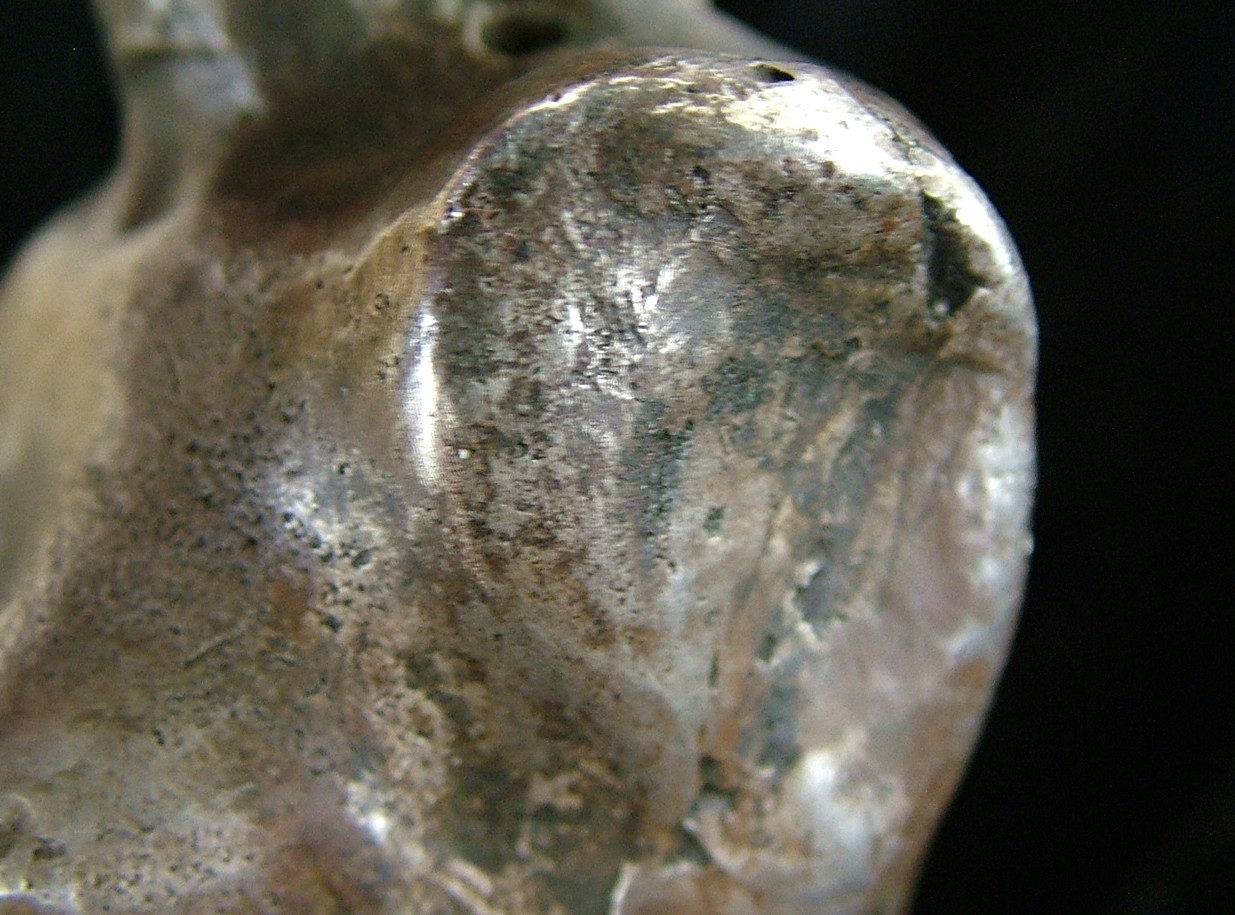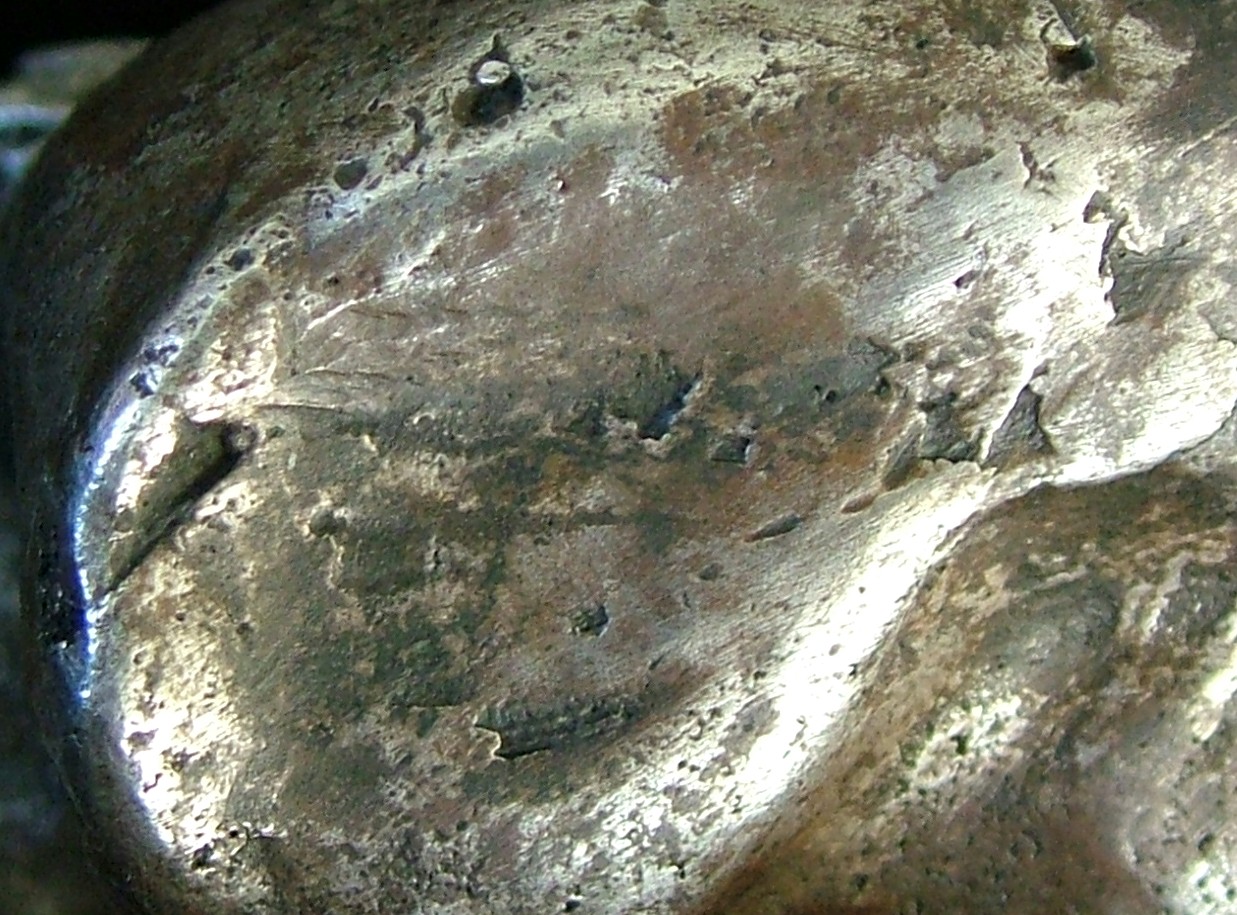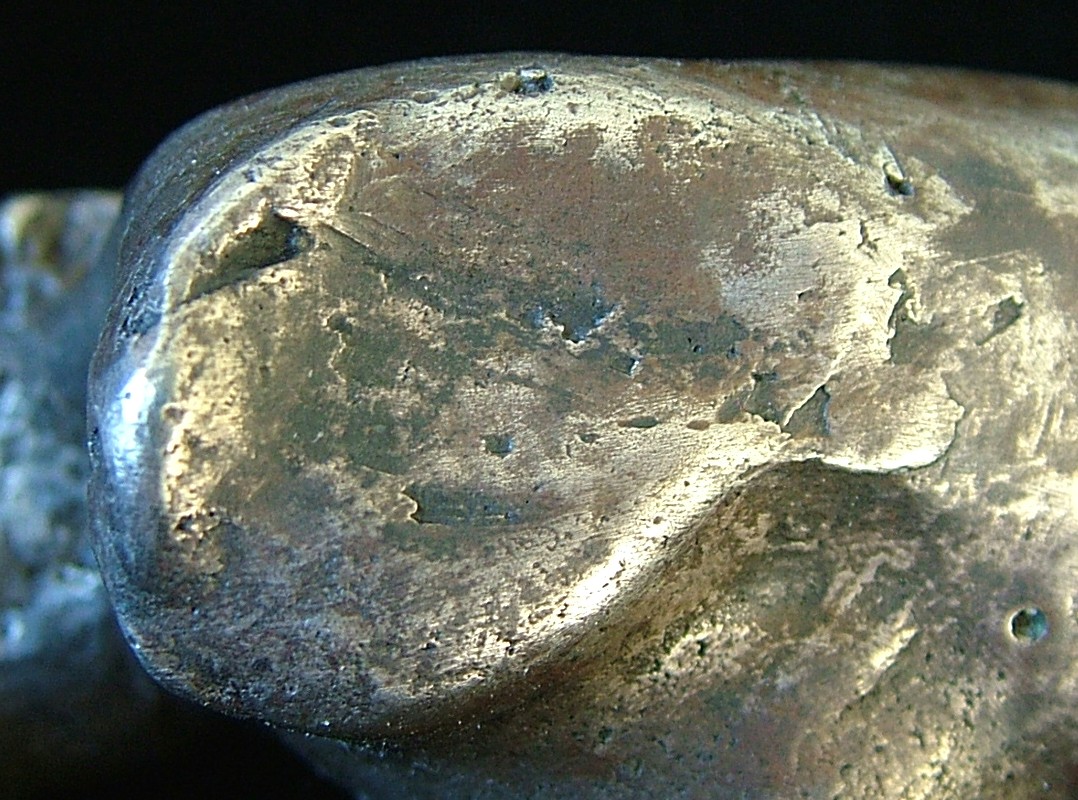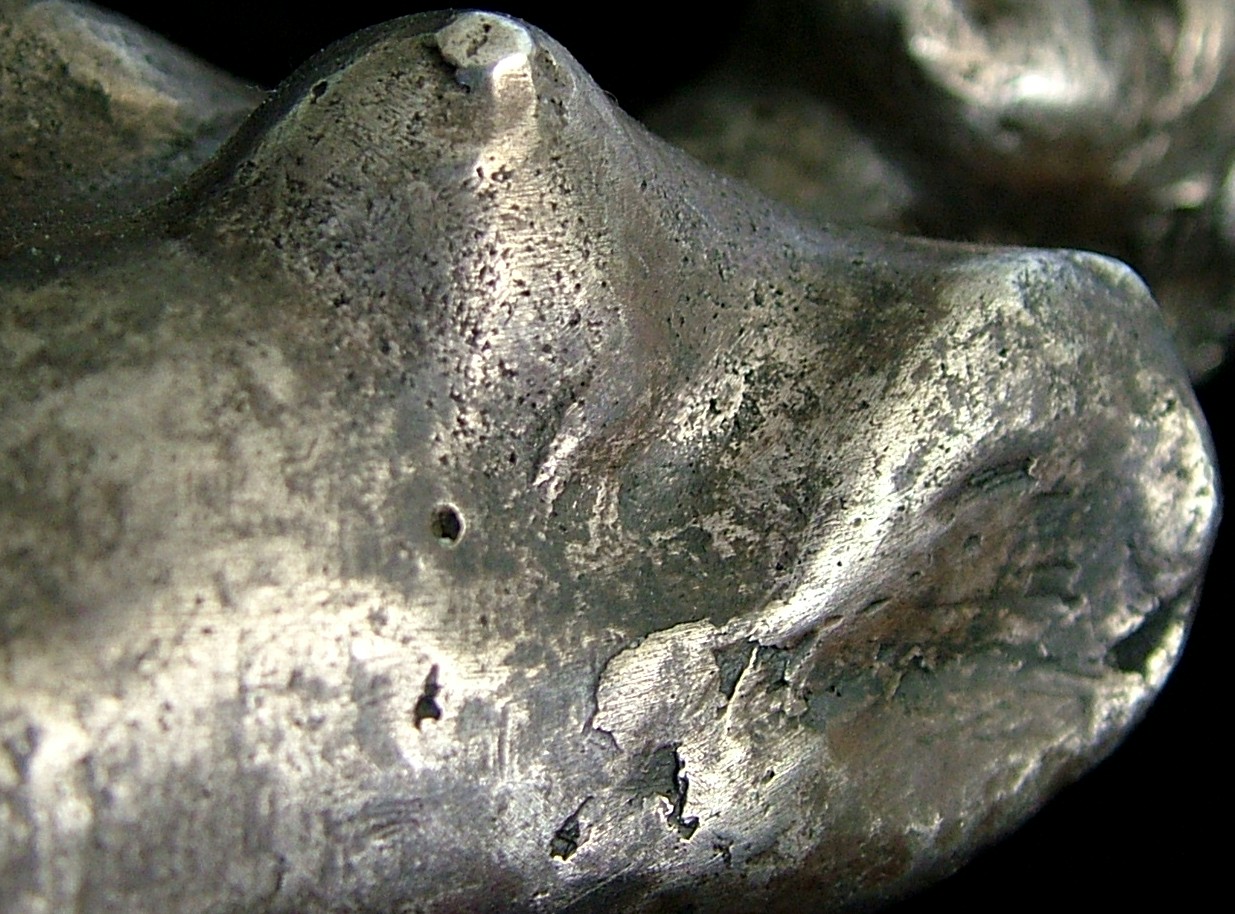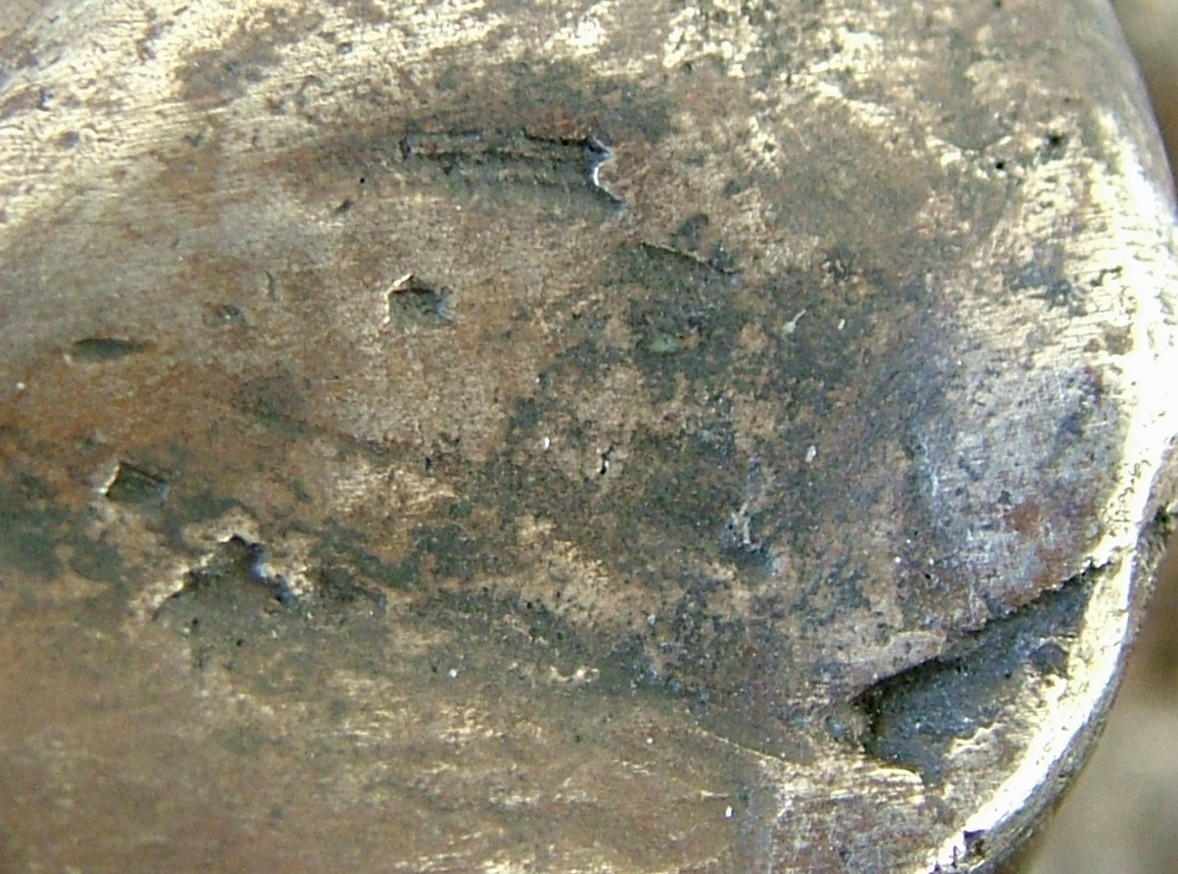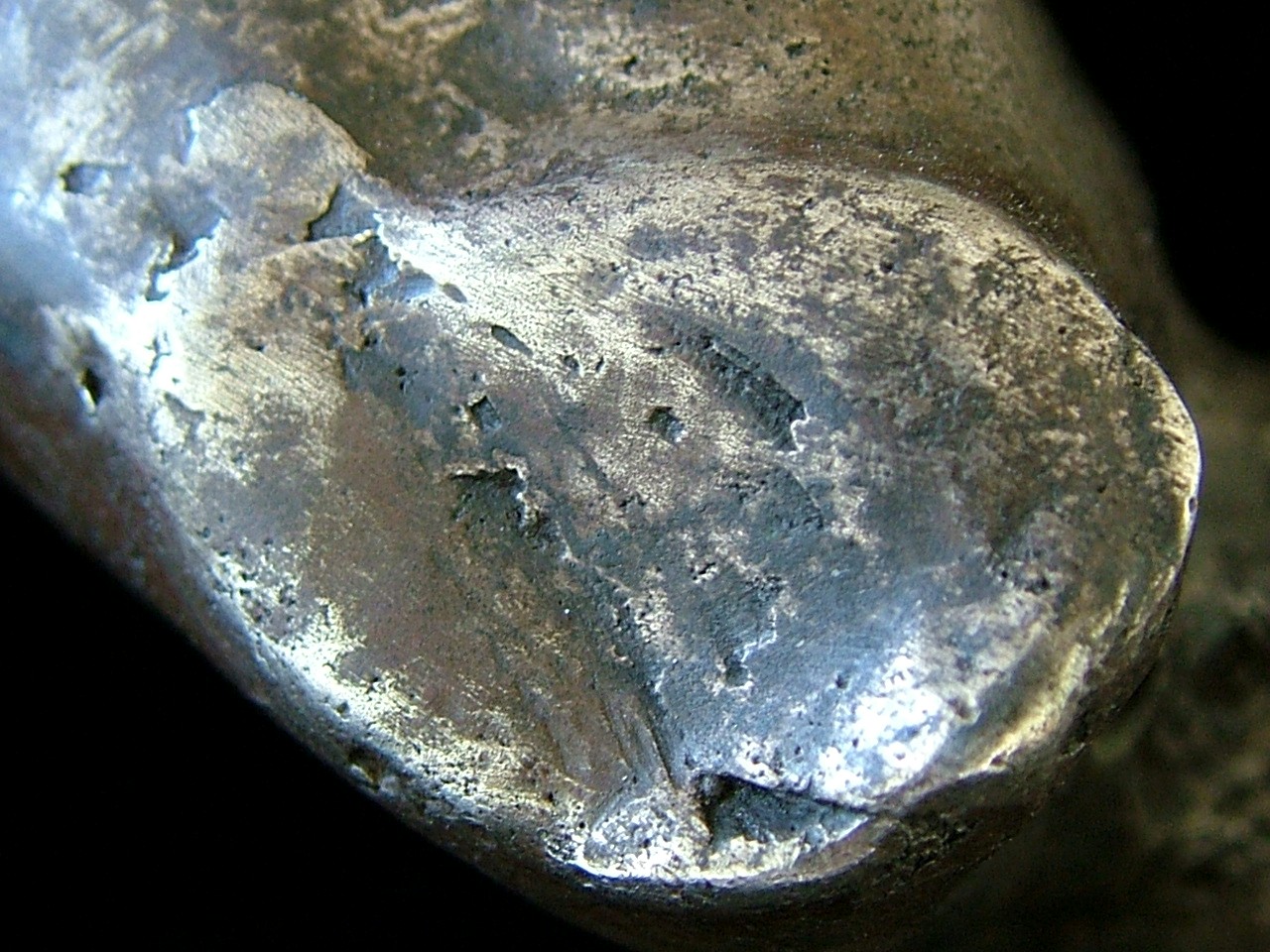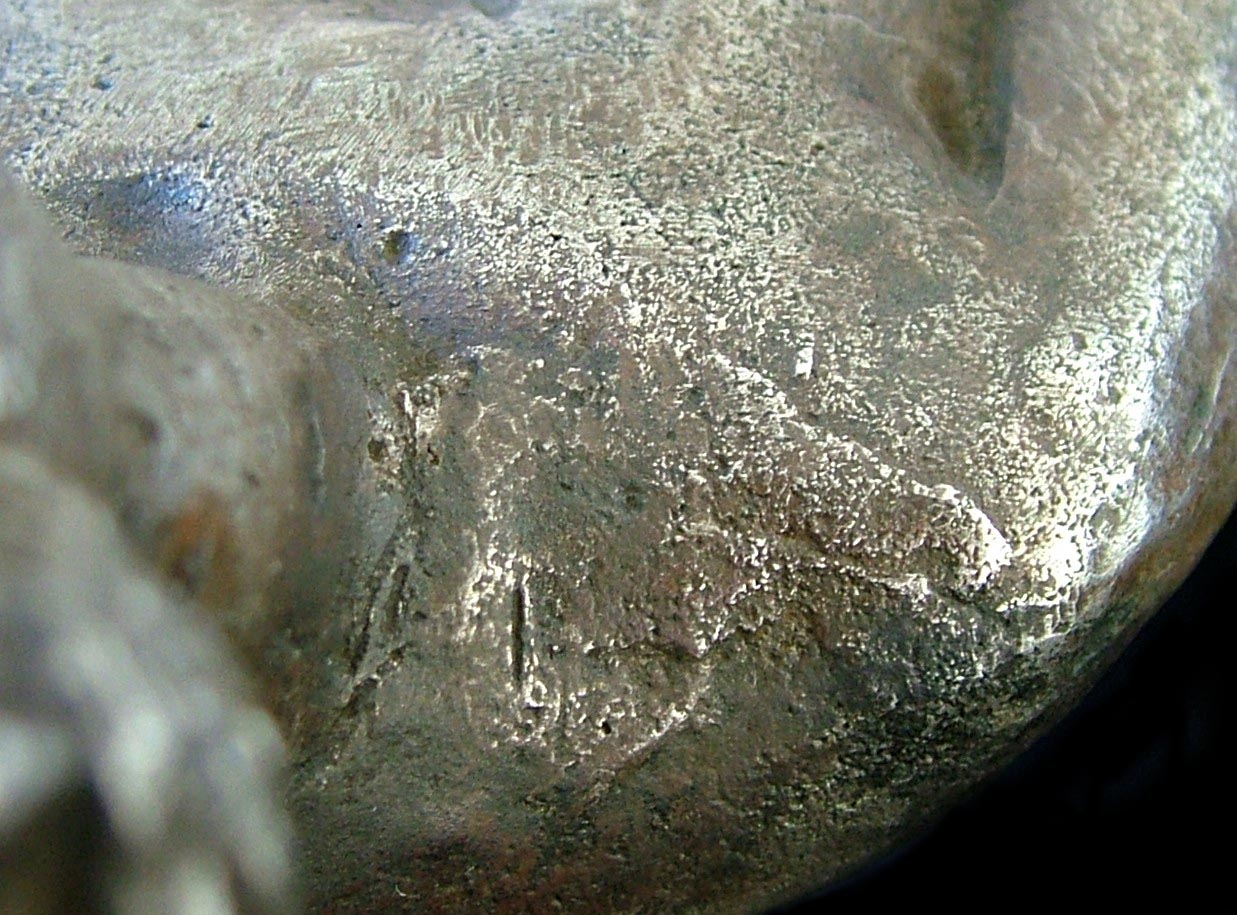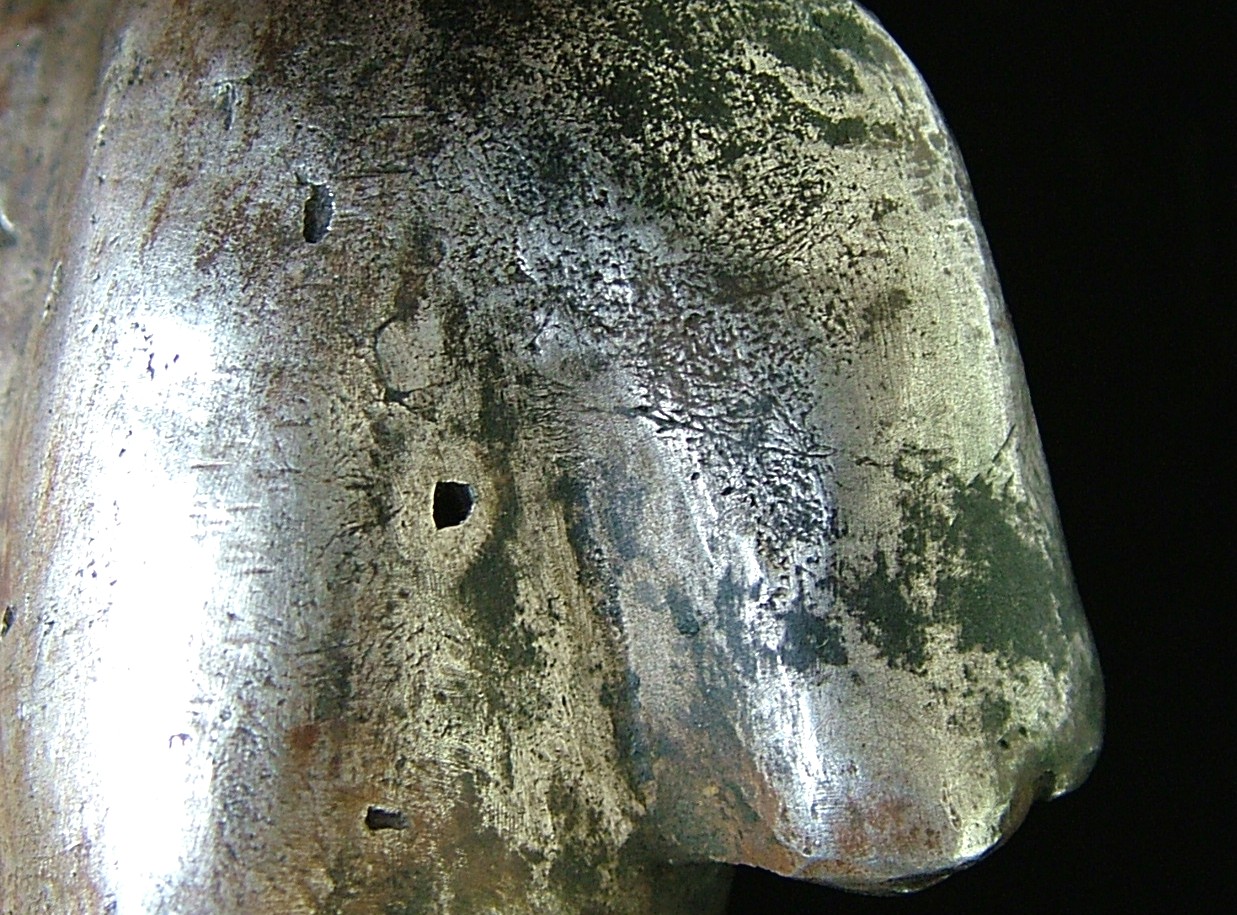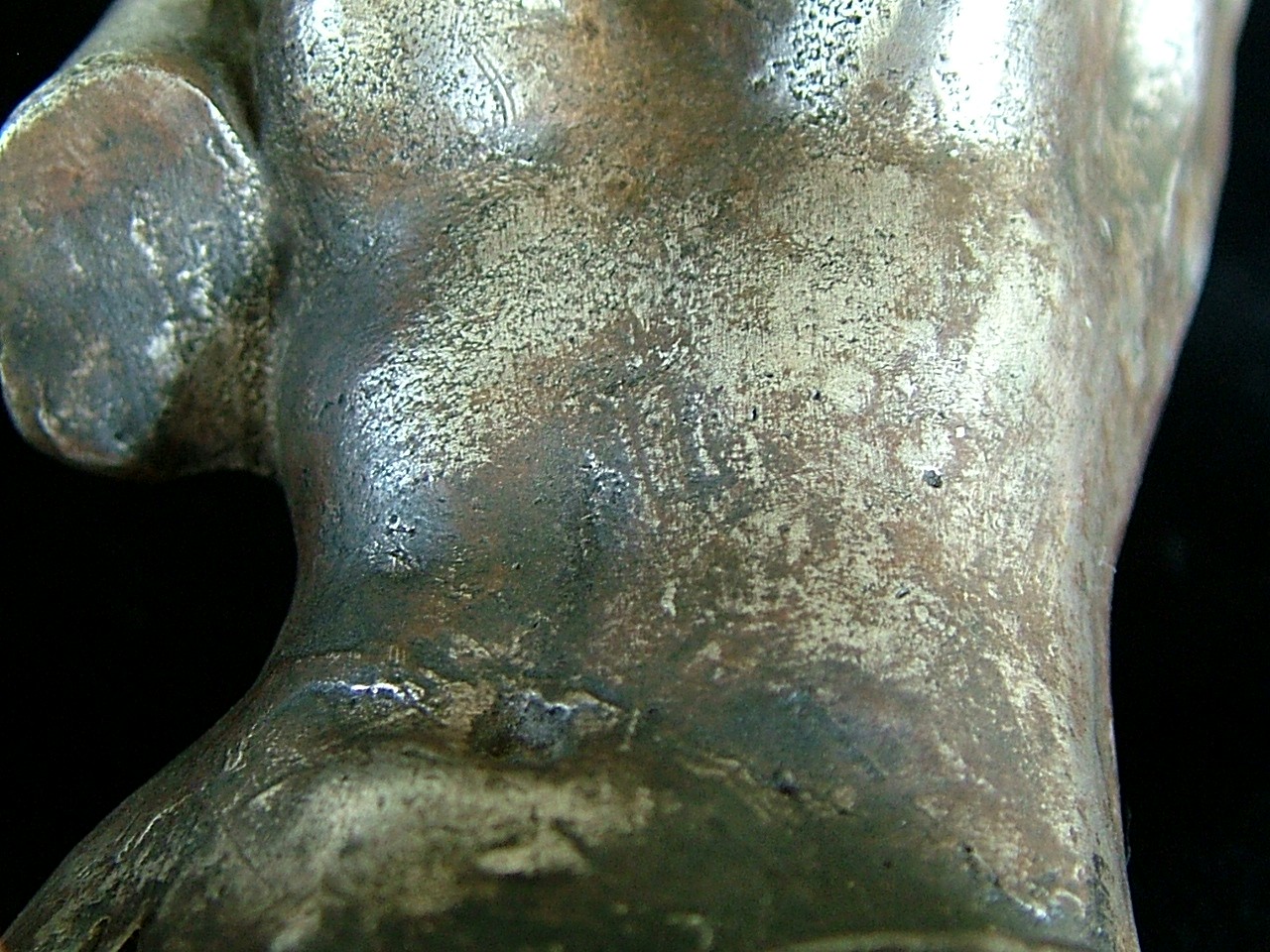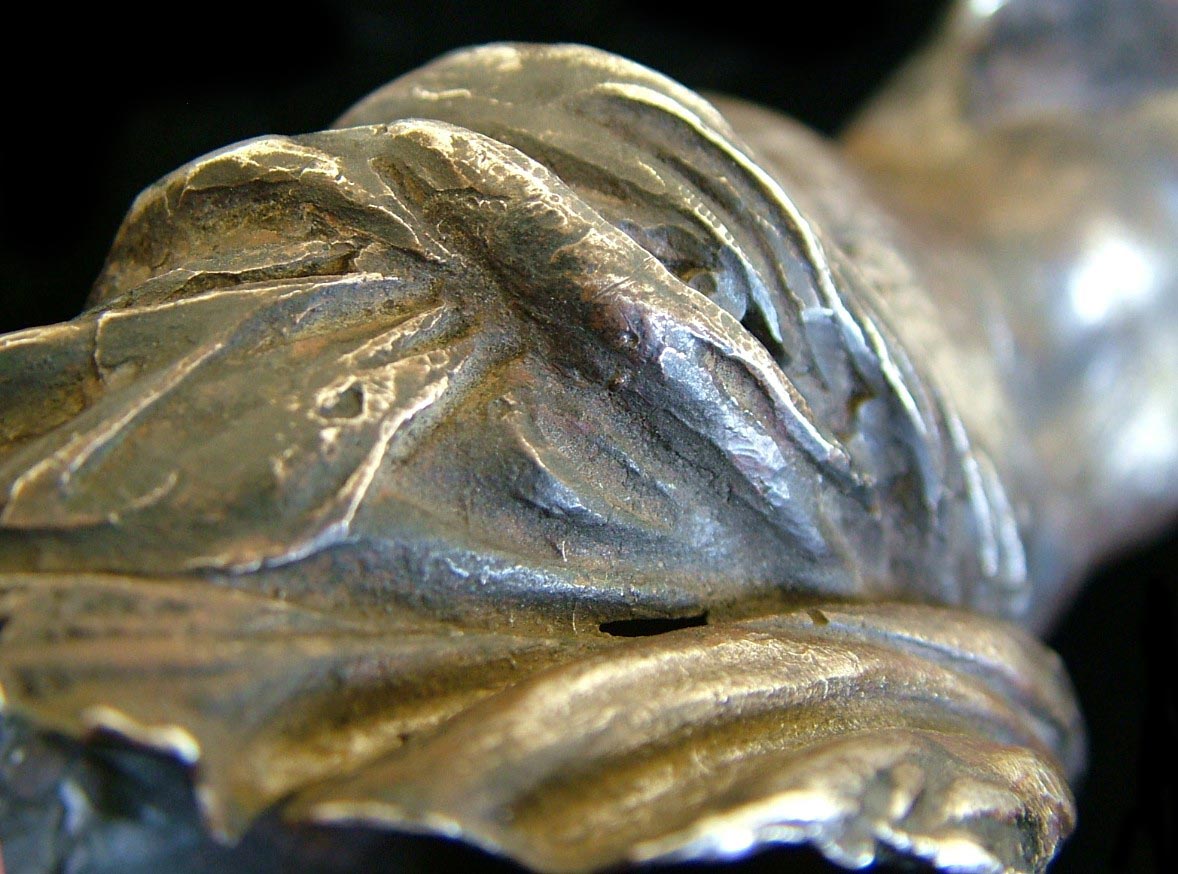 |
|---|
Venus X South Beach |
|
| The Veuns Victrix Standard |
|
| There are many images of the details with the miniature art on this artifact, along with the information provided it may take up to an hour or more to absorb it's content. If you are interested in new discoveries on the subject of Rome, then in my opinion it is well worth the effort. This is a silver, silver/tin alloy that is tinted, and waxed. It is the sacred standard statue of the Venus Victrix of Legion X Venaria. It is named Venus X South Beach as this is where it resides and the fact the there are many Venus 10's in South Beach. At some point, possibly after the disbandment or re-designation of the legion it was made into a torch holder, it is made to fit comfortably and exact in the right hand. It is 16.5 cm in length and originates from a collector in Germany, the collector purchased it directly from an excavator in Split, Croatia in the 1960's. This posting contains new information, for now the original pictures and information is still available on this website, it is the first artifact listed in the Roman Amazon Permanent Collection. The iconography and inscriptions on the inside of it show that it is of Julius Caesar's Legion X Equestris's Venus Victrix as a sacred standard of the triumvir Marcus Aemilius Lepidus for his Legion X Venaria. Along with this iconography there are suggestions that Caesar had intended to prohibit all blood sacrifices, this may have been in imitation of Rome's second King Numa (who according to legend reigned from 717 to 673 BC), but there may also may be connection to a Germanic tribe with this. It also seems that Caesar (or Lepidus in Caesar's name) created a cult of the god Mithra (an all male mystery cult and a favorite of the Roman Army), or a cult very similar. Along with this; due to Caesar's zodiac sign of Tarus, his family's association with the bull, and the fact that he was assassinated by daggers; I think that the theory that Caesar knowingly and willingly went to his death has merit. This theory was recently brought forth by the Italian Carabinieri Colonel Luciano Garofano and criminal profiler Dr. Harold Bursztajn of the Harvard Medical School. According to what is seen inside this statue Caesar as the taurobolium "may" have been the first and only actual blood sacrifice of the Mithraic cult, that is unlike the taurobolium of the cult of Cybele it was a symbolic sacrifice that was substituted with bread. It could be speculated that at some time in the 1st C. AD Mithraism became more formalized, expanded, but yet maintained it's renowned secrecy. According to my own research with artifacts the advent of this may have been encouraged by the Flavians who appear to have gone to great length to establish a connection to the North Sea and Venus Victrix. There are also suggestions that Legion Veneria had a twin legion in the XV Apollinaris, thus symbolizing the sibling deities Venus and Apollo. There are also indicators that the cult was created after a mystery cult or cults of metal smiths (in my opinion this is where most male mystery cults originate from). Some of the iconography on this statue suggests that this unidentified metal smith cult was possibly connected to the Boeotians, and perhaps to Alexander the Great and his Companion Cavalry. How does this artifact arrive in Split, Croatia is a mystery in itself, but a speculation is that it may have belonged to the Emperor Diocletian (a former Cavalry commander and champion of Mithraism) or to a high ranking member of his court. Diocletian was born in Solin, Dalmatia and had a palace built in what is now Split (then on the outskirts of Solin), this is where he retired in 305 AD. Unfortunately as of yet it is not possible to photograph the inside of the statue near the bottom of the neck, this is where the iconography gives validation to these some of these claims, but there is enough on other areas of the statue that suggest that Caesar was not interested in world conquest through military means (like his hero Alexander the Great), but as a part time archeologist and avid art collector (another words an expert folklorist and symbolist) he was looking to conquer through a belief system based on a mystery religion and through a future gens, if so then he succeeded when Octavian was made emperor, Octavian was devoted to the god Apollo, and then later when another Julia the Emperor Claudius conquered Britannia. How would the conquest of Britannia fit into Caesar's quest for power through Venus Victrix? According to information on other artifacts it seems that the reason Britannia was so valued by various Roman leaders was not due to it's resources or a strategic value, but that it thought to be the furthest known land on the North Sea (although there are indicators that even in Caesar's day that Iceland as the island of Thule was known, that is at least in legend); and that this connected it to legends and myths of magnetic north, magical metal smiths, navigators (due to the magnetic needle of the water compass), Hercules Arctos (who is identified as such from artifacts on this website), Apollo (but of the midnight sun), and most importantly Venus Victrix; there are also suggestions that Mercury and Mars may have been thought as having visited this northern region. Although Caesar had twice campaigned in Britannia, for some unknown reason he decided that he could not or would not take that island, it was the only territory that he had invaded but yet did not seize. According to information from other artifacts the Anatolian Venus (from whom Venus Victrix had derived) was a very ancient goddess that may have in fact originated from stories of a people from a region or a island in or on a northern sea. This can be seen with the ancient Anatolian pre-historic "Ark Knife" on kingarthurbanner.com. Among other things she was a goddess associated with the narwhal, a comet or meteor, blade smiths, volcanoes, and perhaps surgeons. This may suggest that the actual root meaning of the name Caesar (that is thought to mean "to cut") may have been associated with a prehistoric family or tribe that were famed as surgeons. It should be mentioned that although the"Ark Knife may also have been a surgeon's knife it appears that it was specifically used for circumcision. This first group of pictures shows the statue in it's upright position, and then in it's upside down position (when it was used as a torch holder). There are some detailed pictures in the latter position, these are there as to assist the viewer in order to obtain more focus for the rest of the images posted, these were selected due to their having less contrast, eventually with a bit of patience various figures can be seen. |
|
| The Inside of the Statue and the Mysteries of Venus Victrix |
|
| This group of pictures shows that the bottom of the statue originally had a flat ring lip, the remnants of this had been reworked. With the raised area there are hints of a grain sheath, a curved dagger, and a torch. There are three pictures of the inside of the statue. Although not seen in these pictures some of the images are as follows: Three figures with the foremost figure holding a vexillum that has one side shaped like a woman's face in profile, on it is a large " X" (10th) and the letters "LEG' (Legion) but also there is a letter P" for "LEP" (Lepidus), an oven with gold letters and symbols, a bread loaf, a banquet type scene, a figure riding a horse (but when turned slightly the horse will transform into a bull) holding a gladius vertically, on the gladius tip there is a large letter "V', and on top of this is a female figure with no arms (obviously she represents this statue standard). |
|
| Venus's Sword, Troy, the Telchines, and the Cabeiri
| |
| The pictures with this show the sword of Venus, Aeneas, and Troy as Venus's spine. There are hints that the art on this sword "may" also represent a few chakras of a type of Kundalini (Yoga is not thought to have been known in ancient Europe). If so then this "may" or may not have something to do Caesar. It is thought that Caesar was an epileptic and recently it has been "discovered" that yoga may be beneficial to at least some epileptics. The sword's guard is an Asiatic version of the sacred Palladium of Troy (wearing a type pf Phrygian red hat), the hilt is cruciform. In Pictures 9 thru 12 the Palladium can be seen being taken from a roof top to be put on the sword as it's guard. Pictures 2 thru 4 show that each buttock is also a head, Venus's garment is like a vessel with the two heads in it. The head on the left has a monkey type face (although a human seal face cannot be ruled out) with a flipper or fin showing, the human head to the right has a peaked hat. The monkey faced head with the flipper should be one of the famed and very ancient Telchine metal smith/wizards, that is even though one ancient source states that the Telchines are supposed to have originated as the dogs of Actaeon, and that somehow this has been interpreted in recent times as their having dog heads.* The face on the right may be one of the Cabeiri metal smiths. Regardless of who the heads represent they are of two types of metal smiths in a vessel that are connected to creating Venus's sword. *In time this bit of info. may very well prove that we moderns should pay more attention to the legends and archeology of the ancients. There are some that speculate that the Telchines of Rhodes were pre-deluge metal smiths that are connected to the legend or myth of Atlantis, this is due to their having been destroyed by Zeus in a flood (although some were warned and escaped to other islands), in another version it is one of their three cities that suffered a flood. What is a fact is that they were connected to the sea and were thought to be the first metal smiths (they made Poseidon's trident and Cronos's scythe), they also go under other names. If you are a progressive thinker and want to know what this may eventually lead to, then go to the images of the monkey depicted on the C. 30,000 year old Euro Stone listed with the Ancient Miniature Art on this website. It has the oldest known metal worked by human beings, the small bits of metal on the stone are coated with resin (the fossilized resin can be dated at any time) and paint from minerals, so the metal on it could not have been accidental. |
|
| Rock Birth and Knife of Venus Victrix |
|
| This group of pictures shows the area at the base of the spine, it also the pommel of the sword. Pictures 2 thru 14 shows what appears to be a birth from a rock. To the left is a speck of turquoise that is in fact embedded as a gem, some pictures will show the turquoise as two specks, this is due to an even smaller speck of reflective mineral next to this. Pictures 14 thru 18 show a small knife with an ivory blade, Picture 16 shows a silver armless woman to the side of the knife, this should be Venus Victrix and her knife, Picture 17 shows the knife as if carving a symbol that is like a small letter "Y", according to other artifacts this "y" should symbolize a holder of a torch. Picture 19 shows an upside down helmet that may also be a cup. Pictures 20 and 21 shows are standing figures, to the right of this is a tree and with other standing figures. Pictures 22 and 23 show a figure as if pulling a rock with figures from over a rectangle opening, there is a serpent in front of this. Pictures 24 thru 27 shows a figure holding what may be a figure that is lying down, notice the turquoise to the right, in front of this scene and overhead is a bee figure in a cap. There is a small dark area on the lying down figure in Picture 25, this may where the turquoise originates from or where it should go. These images may not be in sequence, but they appear to represent a resurrection, perhaps from a rock or a rock deity. The turquoise should have something to do with Troy, in the ancient world this stone was identified with ancient Anatolia. The ivory knife blade may have something to do with sanitizing. Both the speck of turquoise and the miniature ivory blade may be from relics. |
|
| The Making of the Sword of Venus and the Fall of Troy |
|
| Pictures 1 and 2 show figures that may be of the making of the sword of Venus. With the dyed wax with Pictures 7 thru 9 it is somewhat more abstract but it may show the following; To the left there is a figure holding a wavy sword, under the wavy sword there is a head (but this has a small figure behind it), it as if the figure holding the sword is cutting the throat of the head, There may be a large "H", this may stand for Hector. To the right there is a bearded figure with a kneeling figure in front, the bearded figure has a large arm is holding a small figure as if throwing it at another figure that in front of it, the figure may also be a building This may be the rape of Cassandra (who is also made as a bind letter "CS" and another "S") by the Lesser Ajax and the using of Hector's son (Astyanax) to club King Priam (who has a large letter "P" and a smaller "R"), although Ajax is never mentioned as killing Astyanax, in two ancient writings it is Neoptolemus that kills Astyanax. Picture 10 shows what looks like an acorn. Picture 11 shows that the acorn is in a torch holder, there is a distinct letter "V". Picture 12 shows a hooded figure as if feeding a face, there is a smaller figure on the hooded figure, next to this is a small line figure as if fleeing. Pictures 13 thru 15 show what may be a bull's head and an eagle holding a knife. |
|
| Magnetic Initiation |
|
| Picture 1 shows a human figure in a bull horned hat or helmet facing the statue's right eye, the figure holds a sword or dagger. Picture 2 shows figures in and on the statue's left eye, it is as if there is a struggle or an attack. Pictures 3 thru 7 show the statue's nose as a capped mushroom, inside this there is a bent cross on a hill, as well as figures and a scene below. Pictures 9 thru 11 show a sword under the nose on the center of the upper lip, the hilt has symbols that appear to represent energy (such as lightning, thunder, and the magnetic), the sword's blade is on a figure in a cap or helmet's left shoulder. Pictures 12 and 13 show an eagle's head on the neck, there are symbols and figures in front of this. This group of pictures should represent a mystery and an initiation that had been derived from a metal smith's guild, the sword on the should may be a form of what would become known in Medieval Times as a dubbing. In my opinion the bent cross symbolizes the pull of magnetic north. Various other artifacts show that any symbol on ancient artifact that is on the lip under the nose is always associated with the magnetic and the water compass. A bent cross is seen on another artifact that is a small bronze seal/bread stamp, that cross is on the forehead of a face. With the artifacts on the Roman Officer Permanent Collection, notice that the hilt on the "Roman Secutor Gladiator Ceremonial Gladius of Commodus as Hercules of the North" is also bent to one side. |
|
| Venus Victrix the Sea Amazon and Goddess of Apple Island |
|
| This group of pictures shows the chest and breasts of Venus Victrix. There are various blade weapons, some are connected directly to her breasts, this suggest that she is an Amazon consort to a specially to a blade smith. This is best seen with the right breast in Pictures 6 thru 9 (a blade can be best seen in Picture 9), notice that there is also a dolphin's head. There is a figure/figures holding a long handled spoon between her breasts, in some pictures this spoon can be seen as a spade shovel. In some pictures an apple seed can be seen as if being cut from the inside bottom of her left breast. Picture 16 shows this area as a large dragon's head. Picture 17 shows this area now as somewhat of a sarcophagus. Pictures 18 thru 23 show her left breast as a hill or a mountain, but quite possibly also an island, there are various different figures on and around this. Picture 20 shows a mermaid holding a mermaid child on her nipple. Pictures 24 and 25 show various figures on her left side, just under where her arm should be. At appears that these pictures show that Venus Victrix was among other things a war goddess of the sea, but also the goddess of resurrection of "Apple Island". |
|
| Caesar's Defeat of the Suebi |
|
| Pictures 1 shows the dyed wax area on the left shoulder of Venus Victrix. Pictures 2 and 3 show a large horse's head, there is a hole. Pictures 4 thru 6 show a scene on the neck, it may be of a battle. Pictures 9 thru 12 show Germanic warriors and a standard. Pictures 13 and 14 are most important as it shows a large head of an animal with it's snout in a vessel facing to the front, to the left and just under the hole is a distinct sitting Germanic warrior, he wears the famed Suebian knot, it is no doubt a defeated Suebian warrior. Pictures 15 thru 17 show a Germanic warrior wearing a helmet with a streamer. Pictures 18 and 19 show Caesar victorious, there is a standard, although much lighter, just under this is a square with an"X" on it, this should be the vexillum of Legion X Equestris, to the right of Caesar there is a Roman with a rectangle shield. Pictures 21 and 22 show what appears to be a large bear, there is an execution scene with heads over a stand being dispatched by a figure to the right, there is little doubt that these are to go into the hole that is in front, notice the spatha on the left. Pictures 23 thru 27 show various views and details of this scene. Pictures 28 thru 35 show various views of the hole and the inside of the hole. It should be noted that this hole is near the inside that has the details mentioned with the second title "The Inside of the Statue and the Mysteries of Venus Victrix". This group of pictures no doubt shows Caesar's defeat of the Germanic tribe of the Suebi in 58 BC. There are hints that this was considered a very important event, in my opinion Caesar may have learned something from the Suebi or their leader Ariovistus, it may have had something to do with legends of the existence of Thule (perhaps as Apple Island), but also perhaps a bovine worship of this tribe, they "may" have not had blood sacrifice of this animal. |
|
| Venus Victrix's Narwhal |
|
| Pictures 1 and 2 show the area where the left arm should be. There is a large "V" with faces, the "V'" may also represent bee antennae. This "V" may just represent Venus Victrix, but after looking at the faces in detail, there are suggestions that it represents both Venus Victrix and Vulcan. Picture 3 shows a Roman legionary with a long pointed sword on this area. Pictures 4 thru 13 show a large headed whale or dolphin, in front of this is a girl or a woman that is taking a tusk or tooth from it's mouth. This should be a narwhal and it's tusk (even though it is much shorter then an actual narwhal tusk). Pictures 11 thru 13 shows what appears to be a horizintal long stemmed flower, there is a scene with a box just under this, it is as if objects are flowing to it. This group of pictures should represent the narwhal of Venus Victrix. |
|
| Venus Victrix of the North |
|
| Picture 1 shows a large head in a wide brimmed hat or helmet wearing a collar, in front of this is vertical flower, the hat or helmet style hints that this may be the god Mercury. Picture 3 shows a cut out of a gladius blade with two rods, this may have to do with sword making. Pictures 4 thru 11 show the flower, it has a bead inside. To the right there is a figure in a helmet with a ring, over this is a dragon standard. With Picture 5 there is a sword with a twisted hilt that may represent a narwhal sword. Picture 12 shows the bead in the flower as a face, it should be mentioned that the metal of this bead is uniquely textured, it appears to be very light in weight, it may represent a pearl. Pictures 13 and 14 shows objects as if flowing towards the box. Picture 15 shows this area of the statue as a comet or a meteorite. Some of the Pictures 15 thru 16 shows the following: A figure in a helmet with a bear or bear dragon headdress (this bear or bear dragon with a cap is very ancient, it also can be seen with artifacts right up until the Late Viking Era), a pugio in the box (much like a sword in the stone, and under this a wolf or a bull wolf with the bead between it's ears or horns. Picture 22 shows a white figure as if putting it's hand on the helmet visor of the figure in the bear or bear dragon helmet, it may suggest ball lightning. This group of pictures should represent a very powerful force. The figure in the helmet bear or bear dragon headdress may be the god Mars or even Caesar being initiated or ordained, The box may very well represent a type of master lodestone for what was thought to be the origin of magnetic north. There is every reason to believe that this group of pictures represents what some ancients thought was a northern mystery. |
|
| The Pole Star Spike |
|
| This group of pictures shows more details with the large head in a wide brimmed hat or helmet and a Pole Star Spike. Pictures 2 thru 5 show a ship with figures, there is a large cross, it is as if the ship is landing. The inside of the flower has figures inside of it, there is a larger figure over the flower. Pictures 5 and 6 show a figure that hints that it is a rabbit. Pictures 7 thru 21 show the top of a Pole Star Spike, the Pole Star Spike is seen on many of my artifacts, in my opinion it was not just a Nordic symbol, but rather it was a somewhat universal symbol for the Pole Star in ancient Europe, Anatolia, and Asia. Picture 7 shows a bearded figure in a flat floppy hat that has a face on it, there is a very small figure in front of him. Pictures 8 thru 10 show what appears to be a rabbit man (the ear may also be a chimney type hat, if so then it may represent a kiln) and a pear, but the bottom of the pear is also as an apple. Pictures 11 thru 14 shows the top of the hat, in some of these it appears as if biting or eating a figure. Pictures 15 and 16 show what may be the planet Venus connected to something near the Pole Star. Picture 17 hints at a Roman styled axe. Pictures 18 and 19 suggests a bag, perhaps a bag of coins, a dark bearded figure inside and the letter "V" hints at the god Vulcan. Pictures 20 and 21 what may have something to do with the god Boreas (the god of the North Wind and the bringer of winter). All this appears to represent a journey to the Northern Regions and a mystery of the Pole Star. |
|
| Shaman of Apple Island |
|
| Pictures 1 and 2 show a slightly different view of where the left arm should be. With this the girl or woman is now three figures, the narwhal horn is now a peaked hat for the first figure, there is a hint of a coin in the narwhal's mouth. Picture's 3 thru 5 show that the mermaid is now a merman with a mustache, he is holding something, with this "something" there may or may not be a hint of a smoking pipe, he is over what looks like a coral cave. Pictures 6 thru 10 show the left breast in more detail and at other angles. Picture 6 shows a large seal with it's head as the nipple, under this there is a figure running to the right towards a larger grotesque face. Pictures 7 thru 10 show that the running figure is now a sitting figure with a hood and cape that appears to be an animal skin, he has a stick and there is a bowl in front of him. There are many various animal forms around him (these will change when the statue is moved). The large grotesque face is now a large sitting figure. It would appear that the pictures of the left breast show some type of legendary shaman that was associated with a ritual and deity on an island in the North Sea (Apple Island). |
|
| Caesar's Invasion of Britain |
|
| Pictures 1 and 2 show the gladius with one or two figures under this. There appears to be some type of building going on, they may be building a type of siege weapon, but considering what will later be seen they may be building a type sea craft. Over the gladius are the letters "G" and "TRIAR". With this the "C" is also a "G" and possibly an "I", so they are bind letters. The "Triar" can also be seen as the word "Train", or "Tran". The "GC" is easy as Gaius Caesar, or the "GIC" as Gaius Julius Caesar. The Triar may refer to an earlier Centurion's rank known as a Primi Pi Centurio of a Triarioum Manipulus, this rank is what would later become the rank of Pilus (First Centurion). The word "Train" or more likely "Tran" should be a prefix for "Going Beyond". This appears to read "Gaius Caesar's or Gaius Julius Caesar's First Centurion went beyond". Picture's 4 thru 7 shows the detail with the box or lodestone box, there is a splitting or a bridging going on, there are figures in the flower. Picture's 8 thru 13 show the gladius upside down, it now appears as a ship or boat with legionaries on it and some disembarking and others disembarked. The ship's fore hints of a red bird's head (if so then it is most likely a wood pecker as the bird of Mars), but it also hints of a slopped helmet (typical of Roman sea forces), but more important is that there is what appear to be inflated skins on the bottom of the fore, this very much suggests an amphibious landing craft. With Pictures 8 thru 11 there is a legionary that is forward of the boat, it as a bit like he is holding a type of standard. The standard makes for a large letter "B", inside this is a smaller cross that can also be seen as a Latin number "X". This group of pictures depicts one of Caesar's two invasions of Britannia (55 and 54 BC), but it is likely it is of the latter invasion. With the first invasion Caesar used his VII and X legions and Cavalry (that never arrived), for the second invasion Caesar used five legions and Cavalry, except for Legion VII it is not know which other legions were used, but it is highly likely that Legion X was also present. As of yet I have no speculations as to what the scene with the box may represent. |
|
| The Sword In The Stone |
|
| This group of pictures is of the area that shows the box or lodestone box as the "pugio in the stone". Picture 1 once again show the comet or meteor, compared with Pictures 6 thru 8 it shows that a "gladius in the stone" is sent from above along with the comet or meteor. Picture 2 shows once again shows a pugio in the stone. Pictures 3 and 4 shows one type of sword in a stone. Picture 5 shows another type of sword that is in a stone. Pictures 6 thru 8 show a distinct gladius in a stone that is also a clean shaven head with smaller figures on it like a laurel, this very well may be the Sword of Mars. On the head appears to be the letters EESO", in Latin eso means "to strive for", the first letter is slightly like a letter "C", so it may also be the letters "CES" for Caesar. Pictures 9 and 10 show a standing figure that is shaped somewhat like a club, there is a very large wavy sword, this sword appears to be castrating or even cutting the buttocks off the standing club figure. This may have something to do with the making of the sword in the stone, or it may represent a punishment for a transgression. Whatever this symbolizes the club suggests that it has something to do with the demi-god Hercules. |
|
| Caesar 's Plans for Rome in the East |
|
| This group of pictures shows the right shoulder and the back of the right side of the neck of the statue. Picture 1 and 2 shows what may be a fantastic combination creature with figures on it, on the left of this is a distinct lion facing. Picture 3 shows what appears to be another fantastic creature with figures on it. Pictures 4 thru 6 shows a large face in a helmet (but only the front of a helmet) facing left, this blends with many figures on the back (this scene may represent a city), it hints of a legionary, on top of this helmet there is a perched lioness facing to the right, the art style hints at the Middle East and Egypt. Pictures 7 thru 10 shows a large face in an Asiatic type helmet. With a closer view it shows a standing figure with an open scroll with three or more figures in it, the scroll is as if breaking out of a turret type enclosure. Next to this is a long fortress wall that has a large bear descending on it. Pictures 11 thru 14 shows a cave like enclosure, there are various figures over and in this, there is little doubt that this is of a mystery. Pictures 15 thru 22 show this area in a different position, there are many various figures and scenes around this and inside the enclosure, with this Pictures 21 and 22 show that to the left of the enclosure there is a woman's face on top of a man's face, they very much appear to be Romans. The images with this group of pictures may suggest somthing to do with Troy, but also that Caesar had intended for Rome to conquer the east and south through the written word, there is also a hint that at least some Romans had heard stories of the Great Wall in ancient China. Notice that there is not a "conquers hole" as there is on the other shoulder, this may suggest that Caesar was comfortable as being perceived as more of a conqueror with the peoples of the west and north, but not so with the peoples of the east and south. There is more with this area, but just as with other miniature art on this statue, it either has not been photographed or is not included with these pictures. |
|
| Venus Victrix's Trojans and the Water Compass |
|
| This group of pictures shows the right quarter arm of Venus Victrix. Pictures 1 thu 3 show a scene on thev quarter arm in the fold there is a baton. These pictures are not satisfactory as to show the dtails of the baton, other pictures will be retaken at a later date. Pictures 4 and 5 show this area of the statue upside down, there is a figure in a helmet on top that is as reaching to take the bottom of the baton. Picture 6 shows the detail of the baton's bottom, it is a woman or a boy in an Asiatic peaked hat and armor. she or he is holding a round shield in front (but this can also appear as a rectangle shield), this could represent the sacred Palladium of Troy, or it may be the god Mithra. Pictures 7 thru 9 show the bottom of the quarter arm, there is a prominent eye on a large dark haired boy or young man's face with a ring on it, the face is distorted suggesting that he is of a god or a force of nature, there are many figures in front of this. Pictures 10 and 11 shows that the eye could also be a bowl with a bead in it. Although difficult to see the figures on the bottom now show a dragonesque duck or swan headed boat (the duck and, or swan was a Trojan royal symbol), on top of the bird creature's beak is a cup, this has a horizontal white cross on it (the cup and cross should symbolize the water compass), over this is a face with two very small white eyes (one of the eyes is in the ring). The face with the white eyes is part of a larger yellowish face with faces in it (this yellowish color may hint that it is the god Apollo of of that solar god). Picture 12 shows that the boy is holding a rectangle box and the ring, there are figures overhead. Pictures 13 thru 15 show various distorted faces. Pictures 16 thru 18 show a dark woman and many other faces on the quarter arm, she is facing the right breast that appears as a bearded man in a Phrygian hat, this facing couple may represent Queen Dido and Aeneas. This group of pictures appear to have to do with the Palladium of Troy or the god Mithra, the water compass, mysteries of the weather, and the voyage of the Trojan Prince Aeneas and his Aeneads. The ring seen may be of an unknown legend or myth to do with Aeneas and the later Roman elites tradition of "the wearing of the gold band". |
|
| Caesar 's Venus Victrix Giving a Caesarian Birth |
|
| This group of pictures is of the stomach area of the stature, there is a focus oh it's naval, it may contain information on the basis for the mysteries of Mithra. Picture 1 shows various figures on the upper and lower stomach (belly). Pictures 2 and 3 shows the right hip and the belly, there are figures and two cutouts. Pictures 4 thru 10 shows an arm and hand over the naval as if dragging a crusiform hilted sword that is cutting the left side of the belly open. The crusiform sword when seen in detail has a knife on it, the hand and sword pommel can also be seen as a sword fish. Inside the naval there is a scene, with this there appears to be some type of broken egg or an egg that is breaking open. On closer examination the sword's guard is actually a type of a tool that is being used to press the blade against the belly, possibly for a precision cut. Although symbolic this is a first look at what the technique for an ancient Caesarian operation may have been like, also it very much suggests that Caesar and, or his gens the Julia were connected to this. Under the sword is a running dog or wolf, over the blade there is a mountain, Pictures 8 and 10 shows crosses on the mountain as if coming to the blade of the knife on the sword, also with these two pictures there is a ball and a baby in a rectangle box, there is a large figure to the right, Picture 10 also shows that the dog or wolf is a janus-headed creature, there are two figures on it's head, they may be Romulus and Remus or the Dioscuri, under the creature's neck there are the letters "RMX". Picture 11 shows a bull's head, next to this is a face in a conical helmet. Pictures 12 and 13 show a creature with a human arm and hand as if grabbing and pulling the conical helmet up, to the right along the helmets edge there is a sword that is sticking into the wrist that is pulling the conical helmet, there is a torch in front of this. Picture 14 shows a scene inside the conical helmet, over this is a large letter "V" and a smaller letter or number "X" (this should be for X Venaria). Picture 15 shows a face in a horned helmet, next to this and inside the conical helmet is a figure. Picture 16 shows the face in the horned helmet, the face in the conical helmet is now as a child's face, both faces are looking at a figure on a leaf, this is on a staff with a vertical "Y". Pictures 17 thru 21 shows that the outline of the naval now appears frontally as a lion's head (but with Pictures 20 and 21 there is also a human face to the right), to the left there is a hint that the lion is holding a baton or a torch. Inside the naval there is a head facing to the front, there is a Boeotian type helmet or hat being placed on it (Picture 20 shows a cross near the top of the helmet). It should be mentioned that the Boeotian helmet is thought to have been the favorite helmet of Alexander's Companion Cavalry. Picture 22 shows figures coming from the naval to the left. Picture 23 shows another type of helmet being placed on the head in the naval, it may have a letter "M" on it. Picture 24 shows smaller figures inside the naval, there is a hint of figure in an Attic helmet with figures on top. Picture 25 shows a spear as if coming from a small mound, there is a figure grabbing it, there is also a letter or number "X" and perhaps a letter "L". Pictures 26 and 27 show the upper half of the spear is like a flaming sword, there are various figures around this. Pictures 28 and 29 show a woman on the spear / sword, it is as she is feeding a darker hooded figure in front of her, there is also a figure coming from inside the blade, to the right there is a figure as if drinking from a horn. This group of pictures should represent a mystery that may have become part of the later Mithraic mysteries, it appears that it is of Caesar and celebrates the birth of a new era by Venus Victrix for her enlightened initiates, at least some of this may have originated from the Boeotians or the Companion Cavalry, if so then it may have been from one of the Boeotian metal smith mysteries. |
|
| Venus Vitrix's Corax and Nymphus |
|
| This group of pictures shows the garment of the statue, much of this area should have to do with the statue standard having been re-worked to be used as a torch holder. Pictures 1 thru 4 show what appears to be a squid. Pictures 5 thru 7 show what may be a bowl, in front of this in a beak type enclosure is a black pearl, in front of these there are standing figures. Pictures 8 thru 11 show more of the same, but the black pearl is now a dark head. Pictures 12 thru 19 show what may be a long haired fish man holding a torch forward, the torch's flame has a figure that is touching the forehead of a darker face, the top of his hair is as an eagle's head, his bottom part is like a fish tail, but it is also like a garment, it is tinted red; there are many various larger and smaller figures around him. With this Picture 19 shows that on top of the fish man there appears to be a legionary, he is wearing a helmet, pilum, and rectangle shield. Pictures 20 thru 27 show a fierce looking dark bird that may also be combined with a fish (it may represent a type of mythical sea raven). This creature's wing or fin or wing-fin is an arm that is also like a sword, under this is a spear. With this Picture 26 shows a figure in front of the beak as if attacking something inside the beak, also with this Picture 27 also shows a head in an elaborate headdress being attacked by the beak from behind. Pictures 28 thru 32 shows a scene with a woman in a dark veil (this veil can also be seen as a large mask) putting something on the forehead of a girl that is front of her, the girl is holding a cup or a bowl that is part of the woman's garment, behind the girl is a torch that has a flame that may also be a red headed bird, but also Picture 32 shows this area as also a large hooded figure. There is every indication that this group of pictures shows something similar to the first two initiation rites of the later Mithraic cult, that is the Corax (Raven) and the Nymphus (Bride). Copyright 2009 David Xavier Kenney |
|

